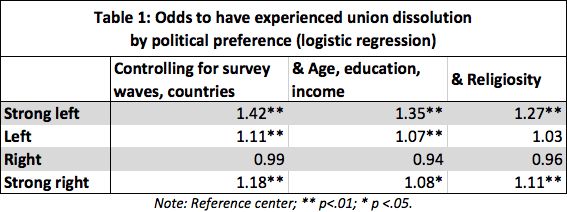Highlights
W. Bradford Wilcox and Nicholas Wolfinger argued earlier this week that according to their analysis of the 2010-2014 General Social Survey, Republicans enjoy an advantage over Democrats when it comes to the happiness of their marriages. Further, Republicans are also more likely to be married, and ever-married Republicans are less likely to have been divorced, than their Democratic counterparts.
Using the same GSS data, Philip Cohen contends that the left-versus-right story on marital happiness doesn’t hold up when political affiliation is broken down differently. Rather than splitting respondents into three groups—Republican, Democratic, or Independent—Cohen uses all seven of the GSS’s party identification options, which makes the sample size for each category so small that the results become statistically insignificant.
Per Cohen’s results, both strong Democrats and strong Republicans are more likely than Independents to claim to have a happy marriage, though strong Republicans are still more likely to have a very happy marriage than strong Democrats and non-strong Republicans have an advantage over non-strong Democrats. One possible explanation might be that all persons with strong political preferences—not just Republicans—are “more optimistic, more charitable, or more inclined to look at their marriages through rose-colored glasses,” to use Wilcox and Wolfinger’s words. Another explanation of Wolfinger is that strong partisans may be people who feel more strongly about all sorts of things, and therefore they’re motivated to make their relationships better.
I replicate in this blog post these USA analyses for twenty European countries. I do not want to endorse any side in the American “culture wars,” but it might be useful to take a broader perspective by comparing the USA with Europe. My aim is to investigate the societal aspects of divorce, which is a topic much neglected by sociologists (see further my keynote address at the 2012 conference in Helsinki (Finland) of the European Network for the Sociological and Demographic Study of Divorce).
Data
I use the combined first five waves of the European Social Survey. ESS is a cross-national survey that has been conducted biennially across Europe since 2001. The survey measures the attitudes, beliefs, and behavior patterns of diverse populations in more than thirty nations. This is the only cross-national survey with information about both political preferences and marital behavior. I use only respondents born after 1940 for the 20 European countries that largely adhere to Latin Christianity (thus no Greece and Bulgaria). These countries (N=83,000 respondents) differ in divorce/dissolution rates, political preferences, and religiosity between one another and in comparison with the USA (Bruce, 2002; Davie, 2002). I apply weights to make sure that the results are representative for the combined population of the 20 countries.
Dissolution is measured by whether the respondent has been divorced or dissolved a civic union. Political preference is measured by a 10-point left-right scale (Benoit & Laver, 2006). Self-placement in the left-right dimension is a quite stable individual characteristic, in contrast with actual voting behavior. I divided respondents into five groups: strong left (10 percent), left (20 percent), center (30 percent), right (20 percent) and strong right (10 percent). Religiosity is measured by subjective self-assessment (regardless of belonging to a particular religion) on a 10-point scale. Income is measured by a four-point scale, which asks whether the household’s current income is sufficient. The ESS does not measure marital happiness; instead I use the question about general happiness (10-point scale).
Union Dissolution
Table 1 shows Europeans’ odds of experiencing a divorce or dissolution by political preference, relative to centrists. Respondents with strong left and left preferences are more likely than centrists to have experienced a dissolution. The same holds for respondents with strong right preferences, while those who lean right less strongly are almost identical to centrists. Strong political preferences (both left and right) remain associated with higher divorce risks even after controlling for age, education, income, and religiosity. The outcome for Europe stands in contrast to Cohen’s finding for strong Democrats and Republicans in the USA. While strong partisans in the USA are more likely to claim to have a very happy marriage, in Europe, respondents with strong political preferences (left or right) are more apt to have experienced a union dissolution than politically moderate respondents.

Happiness
ESS has no indicator for marital happiness; therefore, as a proxy, I use general happiness. Table 2 shows the happiness differences between political partisans and respondents with center preferences. Respondents with left preferences are a tiny bit less happy than respondents with center preferences (.1 point less on the 10-point scale of happiness), whereas respondents with right preferences are happiest by a small amount (.34 points more than respondents with center preferences). Controls for age, education, income, union dissolution, and religiosity make the happiness levels of respondents with left preferences essentially equal to those of the center. But respondents with right preferences are still a little happier than respondents with center and left preferences.

Conclusion
It should be stressed that these results about political preferences, marital stability, and happiness are about associations, not necessarily about causation. To my knowledge, longitudinal data with information on marital and political behavior for Europe do not exist. As far as I know, this is the first time that the relation between marital stability and political preference in Europe has been examined. It should be remembered as well that right-wing parties in Europe are not always religious ones; some can have an anti-clerical stance. Most Christian-democratic parties belong to the center. The association between political preference and marital stability deviates from that between political preference and general happiness.
These outcomes suggest that divorce is not a purely independent act of two adults, but an event influenced by the structure and values of modern societies. However, the relations between these structure and values can differ strongly between societies, as our European results show. While strong right and left partisans in the U.S. seem to be more likely than others to have a very happy marriage and divorce less, in Europe we find the opposite strong right and left partisans divorce more than those with center preferences.
Jaap Dronkers holds the chair in international comparative research on educational performance and social inequality at the Maastricht University in the Netherlands. He publishes on unequal educational attainment, changes in educational opportunities, differences between public and religious schools, achievement of migrants from different origins and destinations, effects of parental divorce, cross-national differences in divorce, and European nobility. He also participates in public debates on topics related to his research.
References
Benoit, K. and M. Laver (2006). Party Policy in Modern Democracies. London: Routledge.
Bruce, S. (2002). God is Dead: Secularization in the West. Blackwell, Oxford.
Davie, G. (2002). Europe: The Exceptional Case. Darton, Longmann and Todd, London.















